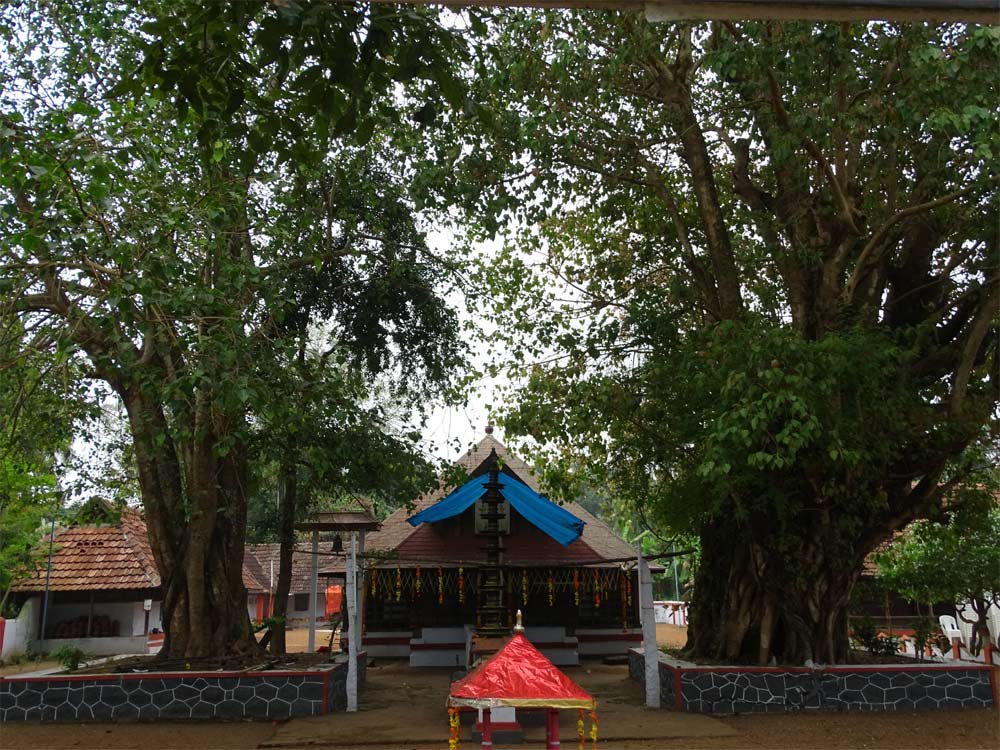“Mathoor Bhagavathi”, the family deity (“kuladevatha”) is the main deity of the Mathoor family. Mathoor Bhagavathi is in the form of Goddess Bhadrakali in a peaceful state. It is said that the nephew of the founder of Mathoor family, Mathoor Panicker had gone for gurukula system of learning of martial arts at “padugaradimana” (pazhaya (old) mana) in Varambally village in Uduppi taluk. While returning back home after the completion of his gurukula education, the nephew was presented a very powerful mirror idol by the wife (the Guru pathni) of the great Acharya Dronampally Naikkar.
About Temple
About Temple

ABOUT THE TEMPLE
About
“Mathoor Bhagavathi”, the family deity (“kuladevatha”) is the main deity of the Mathoor family. Mathoor Bhagavathi is in the form of Goddess Bhadrakali in a peaceful state. It is said that the nephew of the founder of Mathoor family, Mathoor Panicker had gone for gurukula system of learning of martial arts at “padugaradimana” (pazhaya (old) mana) in Varambally village in Uduppi taluk. While returning back home after the completion of his gurukula education, the nephew was presented a very powerful mirror idol by the wife (the Guru pathni) of the great Acharya Dronampally Naikkar.
ORIGIN OF MATHOOR FAMILY
The Mathoor Family is one of the most renowned and aristocratic Nair families in Kerala noted for its contribution to the rich cultural heritage. The Mathoor Temple and the family have remained a major cultural landmark of Nedumudi in Kuttanad for centuries. The invaluable contributions made by the Mathoor Family and its members in the development of Kathakali, Velakali and martial arts are well-documented in the annals of Kerala’s history.
History
Mathoor family’s history is closely linked with the King of Chembakassery, Devanarayanan of Ambalappuzha. It was, as a mark of respect and gratitude that the founder of the Mathoor family, Mathoor Panicker was offered the post of Commander in Chief of Army by Chembakassery Raja of Ambalappuzha for regaining the lost lands from the Chengannur warlords (‘potties’) and for protecting his kingdom. The king himself brought him from Malabar to head his army.
Mathoor Panicker,
Mathoor Panicker, the great warrior and the Commander-in-Chief of the army of King Devanarayanan of Chembakassery, was the founder of the Mathoor Family. According to the matriarchal system which was prevalent during that time, Mathoor Panicker brought his sister and her husband Mathoor Namboothiri to Kuttanad from Kozhikkode. Chembakassery Raja offered the Thanneer palace and the ‘uttupura’ building along with the fertile paddy fields and land at Nedumudi, in and around the current Temple property for the Mathoor Panicker and his family to settle in. The foundation of ‘Mathoor family’ was thus laid at Kuttanad by Mathoor Panicker who shifted to Alappuzha from Kozhikkode.
ORIGIN OF MATHOOR FAMILY
“Mathoor Bhagavathi”, the family deity (“kuladevatha”) is the main deity of the Mathoor family. Mathoor Bhagavathi is in the form of Goddess Bhadrakali in a peaceful state. It is said that the nephew of the founder of Mathoor family, Mathoor Panicker had gone for gurukula system of learning of martial arts at “padugaradimana” (pazhaya (old) mana) in Varambally village in Uduppi taluk. While returning back home after the completion of his gurukula education, the nephew was presented a very powerful mirror idol by the wife (the Guru pathni) of the great Acharya Dronampally Naikkar.
On returning home with the powerful idol of the Goddess in ‘shanta rupam’ (peaceful form), Shri Attupurathu Bhattathiri, an eminent scholar and well respected religious personality, did the “pranaprathishta ” of Goddess Bhadrakali (Mathoor Bhagavati ) at the Mathoor temple. ‘Mathoor Bhagavati – Charitravum Mahalthmyavum’ is a concise book which traces the magnificent history of the origin of the Mathoor Temple and its significance in Kerala’s cultural landscape.
The Mathoor temple was built based on the principles of the ancient architectural system of Vaastu to offer prayers and Mathoor Ambika became the main deity for Mathoor Kalari. Later, Dronambally Acharya visited the temple and Mathoor Kalari and expressed his happiness for setting up the worship of Mathoor Bhagavathi as the temple idol.
The main festival of the temple is during the “mandala masa” which falls in December. The 12 day festival ends on the 41st day of the “mandala masa” which normally is around 26th December. During the auspicious festival days most of the family members from different parts of the world visit the temple for the darshan of the Mathoor Bhagavathi. Kathakali and Velakali are performed during the festival days along with other cultural activities. “Bhagavatha Sapthaham” is also held regularly during the temple festival.
The Mathoor temple architecture reflects the ancient sculptural excellence in wood and stone. The sanctum sanctorum (sreekovil) and the mandapa encompass a big hall, which are surrounded in the west, south and north by a veranda decorated with wooden lattice work. On the eastern side, in front of the sreekovil, is the poomukham (balikkalpura) (veranda) which is decorated beautifully with sculptures of Surya, Sages, Hanuman, Rudran, Kiratah Rudran, and Arjunan.
On the ceiling there are square panelsdepicting Navagraha sculptures and stories of Panchali Swayamvara, Bakavadham, and Rugmini Swayamvara.
Two beautiful mighty Banyan trees adorn the temple right in the front on either side of the poomukham. A huge traditional ‘kamba lamp’ is placed in the middle of the two Banyan trees in alignment with the main deity of Goddess Bhadrakali.
The ‘Kalithattu’ on the eastern side, at the entrance to the temple, with beautiful panels of wooden sculptures lining all across the ceiling was a major centre of cultural activities. It is documented that Kunchan Nambiar during his stay at Mathoor family used to write many of his Thullal stories sitting at the Kalithattu of Mathoor temple.
A small temple is also dedicated to the founder of Mathoor family(Karnavar). The temple also has other deities/upa prathishtas around the chuttambalam. The Upa Devathas are Kodumkali, Nagarajavu, Shastavu, Rakteshwari, Gandharvan, and Yakshiyamma. The Thevara Moorthies are Sivan, Ganapathy and Dhanwanthari. The temple has a thidappally (kitchen) to the south of the temple.
There is a traditional ‘Naalukettu’ called Valiyapura towards the Northern part of the temple complex. This building is more than 300 years old and has a beautiful stone laid courtyard and inner stone vault. Valiyapura was mainly used to entertain guests and for practicing Kathakali, Ottamthullal and other art forms which were patronised by the Mathoor family members since olden days. Even today, Valiyapura is used by artists before performance at the temple for make-up, practice and rest. This traditional building is being preserved for future generation as a symbol of the cultural legacy of Mathoor family.
The cultural and martial art activities of Mathoor family in the Kalari and in the temple complex were legendary. The activities of Mathoor family led to the emergence of a proverb which goes like ’ottavum chaattavum Mathooril’ which translates as, ‘Mathoor is for running and jumping’ signifying the active participation of Mathoor family in Kalari and other art forms prevalent during those days.
Temple legends
The legend has it that once Maharaja Swathi Thirunnal informed Mathoor Panicker about his eagerness to visit Mathoor kalari (around the Malayalam year 1011). However, after taking bath, upon entering the Mathoor temple, theMaharaja’s forehead hit the wooden panel and he had a round swelling similar to an Unniappam (small round sweet made of rice, bananas and jaggery). The Maharaja instructed that from that day onwards an ‘unniapam vazhipaadu’ should be given to Mathoor Bhagavathi. It is said that the swelling from raja’s forehead disappeared miraculously fast. The ‘unni appam vazhipadu’ tradition continues to this day at Mathoor Temple. There are several other legends signifying the devotion and love for Mathoor Bhagavati.










Other Pages

Developed by Pixelpearl Media
Copyright © 2024. All rights reserved.



